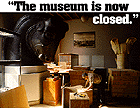 Continued
Continued The University of Chicago Magazine June 1996
The University of Chicago Magazine June 1996 Continued
Continued
conservator, built special climate-controlled facilities to store metals and organics, installed conservation labs," and commissioned engineering studies to find a permanent solution to the problem--at which point the current roller-coaster ride of renovations could begin in earnest.
The Oriental Institute's head curator, Karen Wilson, did her doctoral training in the study of early Iraq, but these days her specialty is ductwork.
"Oh yes, the ductwork-I'll show you ductwork!" says Wilson, laughing, as she flips through a bound stack of architectural blueprints. "I'll show you what I do."
Many planning sessions, programming studies, and schematic designs ago, it was thought that all of the necessary climate-control accoutrements could be housed in the current building. But a 1989 investigation by the Chicago architectural firm of Skidmore Owings & Merrill concluded that the already overcrowded institute couldn't handle the mechanical systems-and, yes, ductwork-needed to distribute humidity- and temperature-controlled air throughout the galleries and storage areas.
Adding a new wing to the historic building sounded almost as tricky, but fortunately its original planners had left the southern facade mostly bare of the rich ornamental details gracing the remaining structure, with a mind to future expansion. "James Henry Breasted thought big all the time," Wilson notes.
The Chicago firm of Hammond Beeby & Babka was hired as project architects. Designers of the Art Institute of Chicago's Rice Wing, the firm, says Wilson, had "a good track record of building sensitive additions onto buildings with a lot of character."
If William Sumner is the restoration project's commander in chief, Karen Wilson is its general in the field, serving as a daily liaison between the institute and all of the outside players-architectural, engineering, and construction firms-who've been hired on. "I primarily represent the customer," she says. "I try to ask the hard questions."
Wilson admits to feeling uneasy at first with managing a project so different from her customary curatorial duties. "Was there a learning curve in this? There was a terror curve." Yet, in one vital respect, her training has held her in good stead. "A lucky thing is that archaeologists know how to read and draw plans. And we deal with isometrics and with scale drawings and sections and whatnot."
These skills have been especially handy in supervising the design of a ductwork system to circulate treated air from the new addition into the galleries. "You can't go through the walls, because they're solid masonry," says Wilson. "And running it outside the courtyard walls would be ugly....So it was decided to bring the ductwork down through the basement and then up into the galleries." Still, "that's proven to be very, very complicated."
For example, to construct the ductwork, many of the museum's display walls must be torn down-including those in the Assyrian gallery, where those giant Khorsabad reliefs now reside. Moving these reliefs, Wilson admits, "is something I have wanted to do since I started here. The way they're displayed now," disjointedly and on separate walls, "makes no sense."
The reliefs will be remounted in movable metal frames and then reunited with one of the museum's main attractions: the colossal winged-bull relief that once guarded the entrance of King Sargon's throne room and which now looms-most illogically-against the east wall of the present Egyptian gallery. Egypt will be moved elsewhere, and the gallery will be dubbed the Khorsabad Court, set up to recreate the main public courtyard of King Sargon's palace.
However exquisite the final results, moving the Assyrian reliefs has been, to quote a museum staffer, this project's "biggest, hairiest deal." But Wilson is satisfied with progress so far, pleased to see that the workmen seem "very aware of the value of these pieces."
In fact, she recalls how on their first day on the job,
Continue reading, "The Museum is now closed."
Go to:
Return to June 1996 Table of Contents